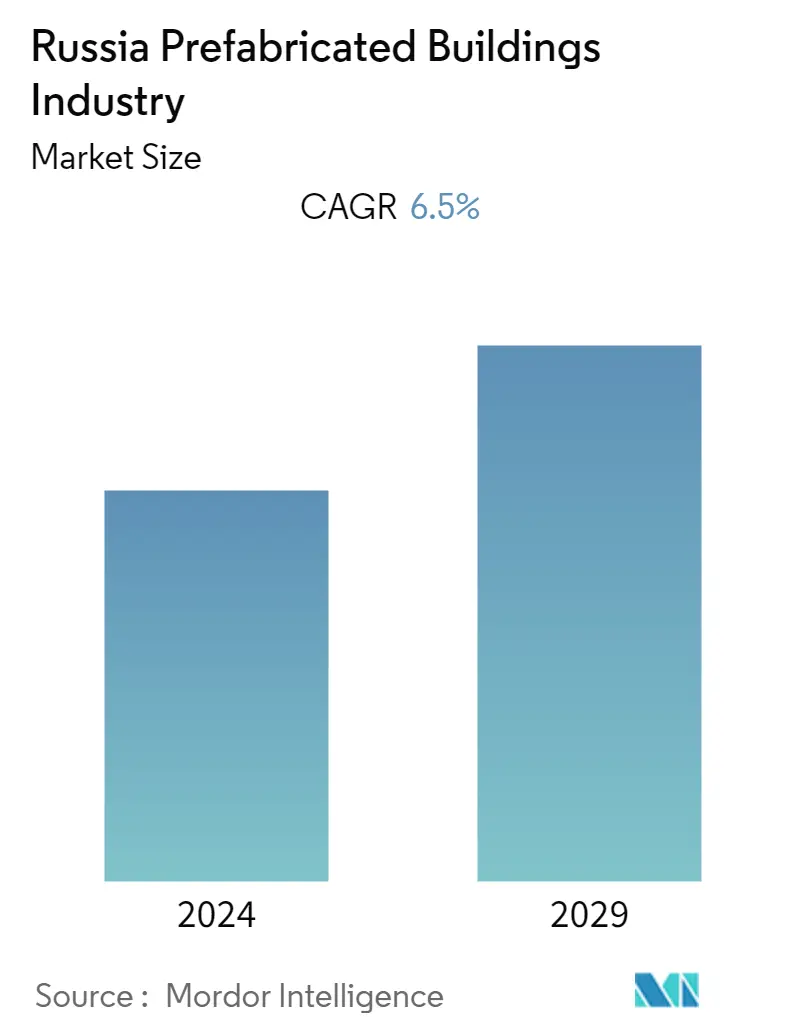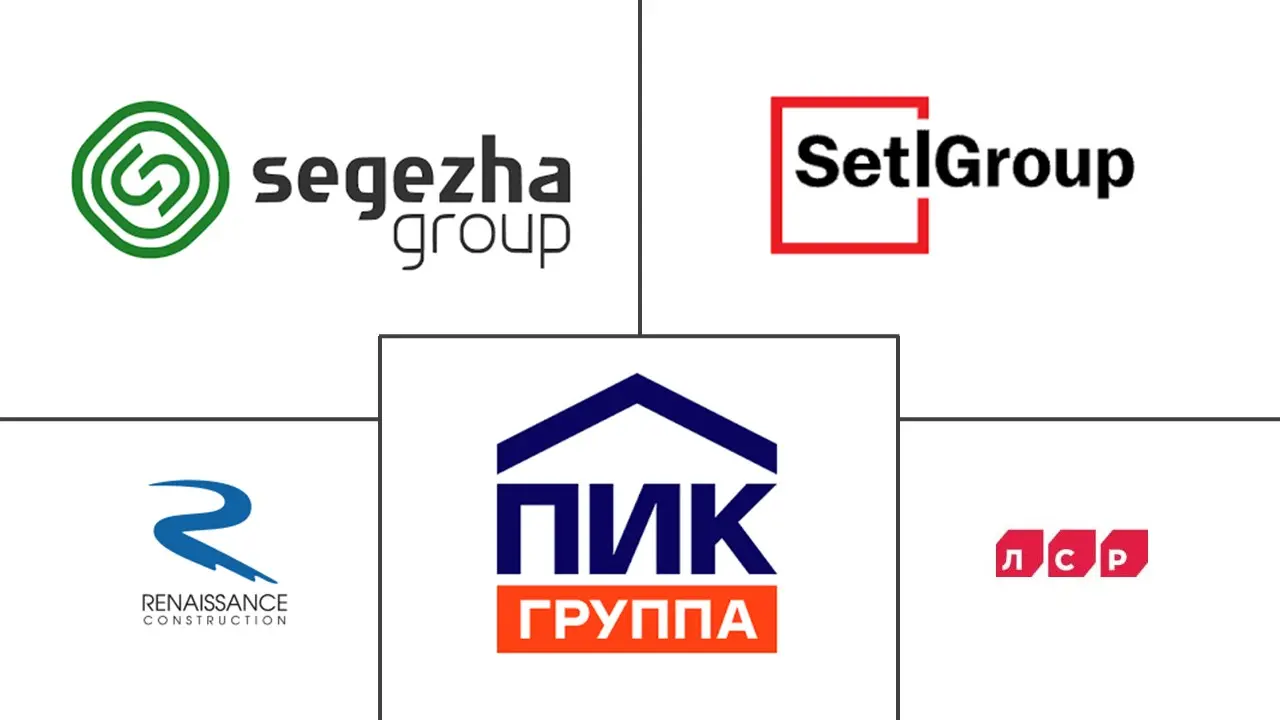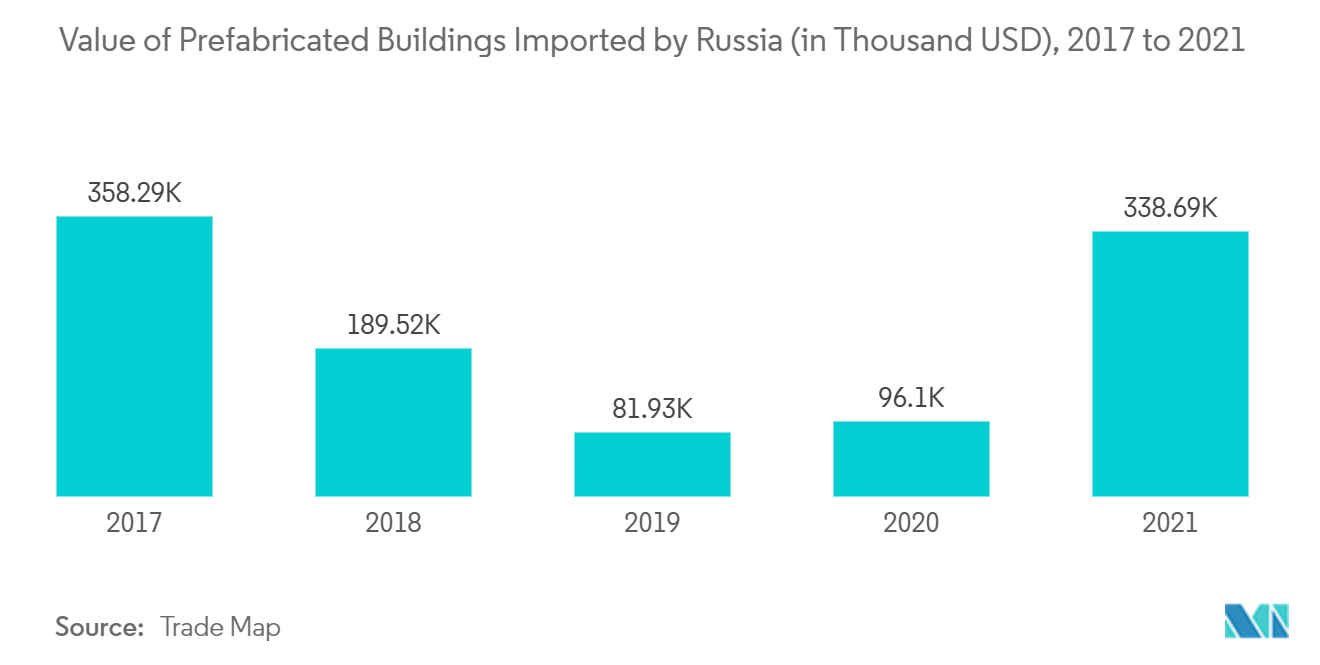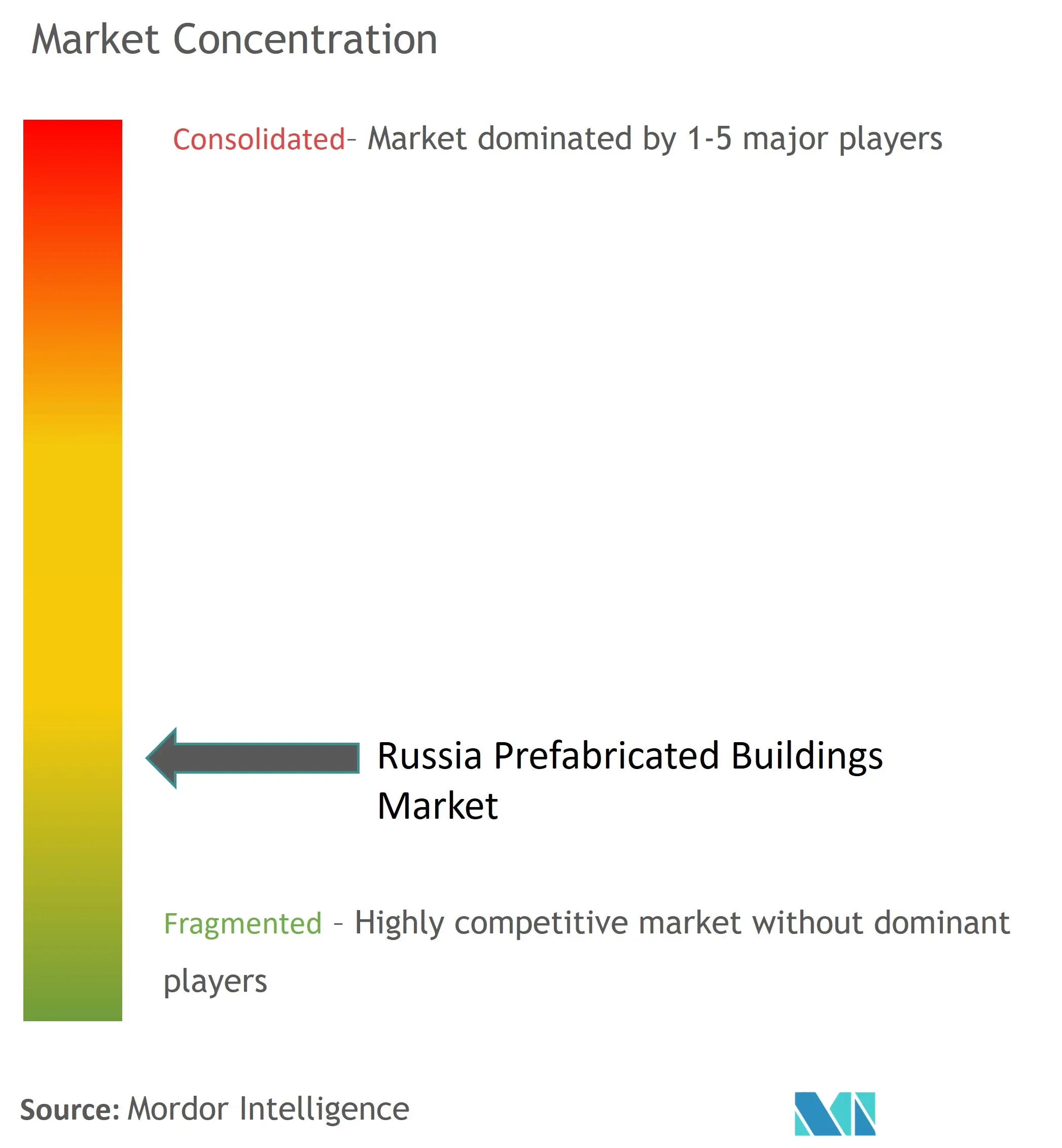Russia Prefabricated Buildings Market Size

| Study Period | 2020 - 2029 |
| Base Year For Estimation | 2023 |
| Forecast Data Period | 2024 - 2029 |
| Historical Data Period | 2020 - 2022 |
| CAGR | 6.50 % |
| Market Concentration | High |
Major Players
*Disclaimer: Major Players sorted in no particular order |
Russia Prefabricated Buildings Market Analysis
The Prefabricated Building Market in Russia is expected to grow at a CAGR of approximately 6.5% during the forecast period.
- The outbreak of the COVID-19 pandemic led to severe uncertainty for vendors and contractors in the industry across Russia. Several construction companies shut down their projects due to lockdowns and restrictions. However, due to immediate requirements for hospitals and quarantine sectors, the demand for prefabricated materials increased. As a large workforce is required for traditional construction, prefabricated buildings are an optimum solution during the pandemic.
- The escalating conflict between Russia and Ukraine, and subsequent U.S. and international sanctions against Russia, have disrupted market operations, mainly supply chain disruption, and the cost of raw materials has increased. With the increasing shift toward turnkey housing solutions, the prefabricated housing market expects to pick up across Russia. Moreover, the ease of preparation and consent procedures are likely to boost the demand for prefabricated houses.
- The country has several companies specializing in CLT production and home construction. CLT is a new product in the Russian market. In many Western European countries, there is a well-developed market for CLT, and it is already used for building residential and commercial buildings of up to 14 stories. Also, new Russian standards for the construction of wooden buildings were announced, which allow for the construction of multi-story buildings using laminated wood framing, which drives the wood prefabricated buildings market.
- The market is being fostered by factors such as lesser construction time required, cost savings, office requirements, rising real estate investments, fast-paced urbanization, rising demand for alternative approaches to construction, and temporary and immediate requirements in the industrial sector. The market is also gaining from the rising customer attention towards reducing CO2 emissions, green construction, and lowering waste.
Russia Prefabricated Buildings Market Trends
This section covers the major market trends shaping the Russia Prefabricated Buildings Market according to our research experts:
The Demand for Prefabricated Building is Increasing in Russia
On September 2022, the Ministry of Construction and Housing of the Russian Federation has approved an Action Plan (Roadmap) aimed at creating the regulatory and institutional framework necessary for the widespread introduction of modular construction technologies in Russia. Some of the benefits of utilizing prefabricated buildings are faster on-site construction, reduced effects of uncontrolled factors, higher quality and consistency, cost efficiency, reusability, less raw material waste, and reduced safety hazards. In the past, the Russian government established requirements for the use of wood in the public housing construction program which has increased the demand for wood in prefabricated building construction.
Increasing demand for energy-efficient buildings is an emerging trend in the market. Buildings account for almost 40% of the world's energy consumption, so the energy production required for buildings is capital-intensive. Modular buildings are energy efficient. As a result, the demand for airtight buildings has increased significantly because they are highly insulated and energy efficient, so they can produce as much renewable energy as possible. These buildings are equipped with ground-source heat pumps (GSHP) and photovoltaic (PV) systems and also have a passive solar structure in the panel housing. In addition, prefabricated contractors and architects design these building models that include features such as solar panels, wind turbines, and even rainwater systems. As a result, such factors are expected to drive the growth of Russia's prefabricated buildings market during the forecast period.

Increasing Costs of Traditional Building Construction over Prefab is Driving the Market
According to the Russian Federal State Statistics Service, the average cost of residential housing construction in Russia has been increasing annually. The figures exceeded 49.2 thousand Russian rubles (USD 0.70 Thousand) per square meter in 2021. To compare, in 2020 it cost approximately 4.7 thousand Russian rubles (USD 0.067 Thousand) less to build one square meter of residential housing. The residential building construction costs continuously rose in Russia, which was driven by high international demand. In addition, construction materials prices are spiking in the country due to the Russia-Ukraine war. The raising costs of conventional construction are driving the adoption of prefabricated structures in the country.
Meanwhile, the major reason behind the construction prices spiking was the rise in prices for building materials like cement, steel, and other insulation materials. For instance, the average price of cement in Russia reached around 6.65 thousand Russian rubles (USD 0.095 Thousand) per metric ton in October 2022. The price steadily rose over the period from March to August 2022. Moreover, the high demand for land and shortage of materials are further increasing traditional construction costs. Currently, prices are growing more sharply than they have in over five decades. In addition, most of the construction and civil engineering companies experienced supply shortages. Thus, the supply shortages in construction materials and rising costs are fuelling the prefab structures market in the country.

Russia Prefabricated Buildings Industry Overview
The report covers the major players operating in the Russian prefabricated buildings market. The market is highly competitive with a few players occupying the major share. Companies are focusing on technological innovations. Some suppliers are providing fully customized, prefabricated wooden structures. High capital requirements and rapid technological advancement are few barriers to entry for new participants. Intensified competition led to the emergence of many innovative and advanced solutions in the market, such as turnkey solutions and lightweight ceramic houses.
Therefore, achieving sustainability, expanding to other regions, and restoring domestic demand are important factors for companies. Companies can implement effective production technologies to minimize product costs and reduce related risks, thereby increasing profitability. Segezha Group, PIK Group of Companies, LSR group, St. Petersburg, and Renaissance Construction are the few major players in Russia's prefabricated buildings market.
Russia Prefabricated Buildings Market Leaders
-
PIK Group of Companies
-
LSR group. St. Petersburg
-
Segezha Group
-
Renaissance Construction
-
Setl group. St. Petersburg
*Disclaimer: Major Players sorted in no particular order

Russia Prefabricated Buildings Market News
- April 2022: Etalon Group (one of Russia's largest and longest-established development and construction companies) acquired YIT Corporation (a construction company) for a maximum consideration of RUB 4,597 million (USD 65.53 million). In terms of the development of construction technologies, the Etalon company's priority is the construction of ready-to-assemble modular multi-story buildings using on-site prefabrication technology.
- January 2022: Dubldom (a modular frame house design company) has designed a TOPOL 27 modular house made of several parts that can be transported by car and put together on-site. Unlike other similar pre-fab homes, it also comes fully furnished with lamps, cutlery, and dishes. Spread over 27 square meters, the home has a bedroom, kitchen, living room, bathroom, and dressing room. The structure itself is also built from natural materials, with oak wood and black metal for walls, and stone for kitchen countertops.
Russia Prefabricated Buildings Market Report - Table of Contents
1. INTRODUCTION
- 1.1 Study Assumptions and Market Definition
- 1.2 Scope of the Study
2. RESEARCH METHODOLOGY
- 2.1 Research Framework
- 2.2 Secondary Research
- 2.3 Primary Research
- 2.4 Data Triangulation and Insight Generation
- 2.5 Project Process And Structure
- 2.6 Engagement Frameworks
3. EXECUTIVE SUMMARY
4. MARKET INSIGHTS
- 4.1 Current Market Scenario
- 4.2 Technological Trends
- 4.3 Insights into Supply Chain/Value Chain Analysis of the Prefabricated Buildings Industry
- 4.4 Brief on Different Structures Used in the Prefabricated Buildings Industry
- 4.5 Cost Structure Analysis of the Prefabricated Buildings Industry
- 4.6 Impact of Russia-Ukraine War on the Market
- 4.7 Impact of COVID-19 on the Market
5. MARKET DYNAMICS
- 5.1 Market Drivers
- 5.2 Market Restraints/Challenges
- 5.3 Market Opportunities
-
5.4 Industry Attractiveness - Porter's Five Forces Analysis
- 5.4.1 Threat of New Entrants
- 5.4.2 Bargaining Power of Buyers/Consumers
- 5.4.3 Bargaining Power of Suppliers
- 5.4.4 Threat of Substitute Products
- 5.4.5 Intensity of Competitive Rivalry
6. MARKET SEGMENTATION
-
6.1 By Material Type
- 6.1.1 Concrete
- 6.1.2 Glass
- 6.1.3 Metal
- 6.1.4 Timber
- 6.1.5 Other Material Types
-
6.2 By Application
- 6.2.1 Residential
- 6.2.2 Commercial
- 6.2.3 Other Applications (Industrial, Institutional, and Infrastructure)
7. COMPETITIVE LANDSCAPE
- 7.1 Market Overview(Market Concentration and Major Players)
-
7.2 Company Profiles
- 7.2.1 PIK Group of Companies
- 7.2.2 LSR group St. Petersburg
- 7.2.3 Setl Group St. Petersburg
- 7.2.4 Segezha Group
- 7.2.5 K Modul
- 7.2.6 Story House
- 7.2.7 Pallada Eco
- 7.2.8 INSI Holding
- 7.2.9 AECON
- 7.2.10 Renaissance Construction
- 7.2.11 Atlaca Group *
- *List Not Exhaustive
8. MARKET OPPORTUNITIES AND FUTURE TRENDS
9. APPENDIX
- 9.1 Marcroeconomic Indicators (GDP Breakdown by Sector, Contribution of Construction to Economy, etc.)
- 9.2 Key Production, Consumption, and Exports and Import Statistics of Construction Materials
Russia Prefabricated Buildings Industry Segmentation
Prefabricated buildings (also known as prefabs) are building structures manufactured offsite and transported to the on-site assembly location. It is made up of parts or units that are made in a factory and then shipped to the building site to be put together.
Russia's Prefabricated Buildings Market is segmented by Material Type (Concrete, Glass, Metal, Timber, and Other Material Types) and Application (Residential, Commercial, and Other Applications (Industrial, Institutional, and Infrastructure)). The report offers market size and forecast in value (USD billion) for all the above segments.
| By Material Type | Concrete |
| Glass | |
| Metal | |
| Timber | |
| Other Material Types | |
| By Application | Residential |
| Commercial | |
| Other Applications (Industrial, Institutional, and Infrastructure) |
Russia Prefabricated Buildings Market Research FAQs
What is the current Russia Prefabricated Buildings Market size?
The Russia Prefabricated Buildings Market is projected to register a CAGR of 6.5% during the forecast period (2024-2029)
Who are the key players in Russia Prefabricated Buildings Market?
PIK Group of Companies, LSR group. St. Petersburg, Segezha Group, Renaissance Construction and Setl group. St. Petersburg are the major companies operating in the Russia Prefabricated Buildings Market.
What years does this Russia Prefabricated Buildings Market cover?
The report covers the Russia Prefabricated Buildings Market historical market size for years: 2020, 2021, 2022 and 2023. The report also forecasts the Russia Prefabricated Buildings Market size for years: 2024, 2025, 2026, 2027, 2028 and 2029.
Russia Prefabricated Buildings Industry Report
Statistics for the 2024 Russia Prefabricated Buildings market share, size and revenue growth rate, created by Mordor Intelligence™ Industry Reports. Russia Prefabricated Buildings analysis includes a market forecast outlook 2029 and historical overview. Get a sample of this industry analysis as a free report PDF download.



